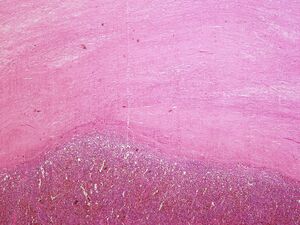Hyaline dystrophy
In hyaline dystrophy, there is a strengthening of the bonds between the structural components of collagen, which in EM have the appearance of thin, disordered fibrils, with more amorphous protein matter between them.
Under the light microscope, hyaline appears as an eosinophilic mass. It stains like collagen – pink in HE, blue in blue trichrome. It resembles amyloid, macroscopically its foci resemble cartilage.
Hyaline degenerated tissue (so-called hyalinized tissue - stiff, hardened tissue) has a tendency to steatosis and to calcification(typically in atherosclerosis. Hyaline is often found in scars and chronic inflammation. In the case of primarily proliferative inflammation of the serous membranes - polyserositis' (Churchman’s disease) cartilaginous hard whitish deposits are formed, e.g. in the capsule of the spleen - coating spleen (perisplenitis cartilage ) or on the surface of free bodies in the peritoneal cavity (corpus liberum).
Links[edit | edit source]
[edit | edit source]
Source[edit | edit source]
- PASTOR, Jan. Langenbeck's medical web page [online]. ©2006. [cit. 2011-10-22]. <https://langenbeck.webs.com/>.

